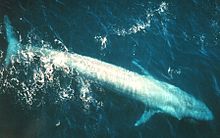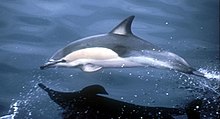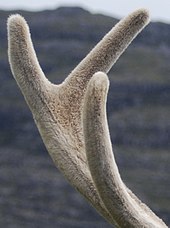Ungulate
| Ungulate Temporal range:
| |
|---|---|

| |
| Image from top to left with Brazilian tapir .
| |
| Scientific classification | |
| Domain: | Eukaryota |
| Kingdom: | Animalia |
| Phylum: | Chordata |
| Class: | Mammalia |
| Clade: | Pan-Euungulata |
| Mirorder: | Euungulata Waddell et al., 2001[1] |
| Orders and clades | |
| |
| Synonyms | |
| |
Ungulates (
The term means, roughly, "being hoofed" or "hoofed animal". As a descriptive term, "ungulate" normally excludes cetaceans as they do not possess most of the typical
Etymology
Ungulate is from the Late Latin adjective ungulatus, 'hoofed'. Ungulatus is a diminutive form of Latin unguis, 'nail' (finger nail; toe nail).[6]
Classifications
History
Euungulata is a clade (or in some taxonomies, a grand order) of mammals. The two extant orders of ungulates are the
In 2009, morphological
There is now some dispute as to whether this smaller Euungulata is a
Taxonomy






Below is a simplified taxonomy (assuming that ungulates do indeed form a natural grouping) with the extant families, in order of the relationships. Keep in mind that there were still some grey areas of conflict, such as the case with the relationship between the pecoran families and the baleen whale families. See each family for the relationships of the species as well as the controversies in their respective articles.
- Euungulata[15]
- Perissodactyla(Mesaxonian ungulates)
- Hippomorpha
- Equidae: Horses, asses and zebras
- Ceratomorpha
- Tapiridae: Tapirs
- Rhinocerotidae: Rhinoceroses
- Hippomorpha
- Cetartiodactyla) (Paraxonian ungulates)
- Tylopoda
- Camelidae: Camels and llamas
- Artiofabula
- Suina
- Tayassuidae: Peccaries
- Suidae: Pigs
- Cetruminantia
- Ruminantia
- Tragulidae: Chevrotains
- Cervoidea
- Antilocapridae: Pronghorn
- Giraffidae: Giraffes and okapi
- Cervidae: Deer
- Moschidae: Musk deer
- Bovidae: Cattle and antelopes
- Whippomorpha
- Hippopotamidae: Hippopotamuses
- Cetacea
- Mysticeti
- Balaenidae: Bowhead and right whales
- Cetotheriidae: Pygmy right whale
- Balaenopteridae: Rorquals
- Odontoceti
- Physeteroidea
- Physeteridae: Sperm whale
- Kogiidae: Lesser sperm whales
- Platanistoidea
- Platanistidae: Indian river dolphins
- Ziphioidea
- Ziphiidae: Beaked whales
- Lipotoidea
- Lipotidae: Baiji (functionally extinct)
- Inioidea
- Iniidae: Amazonian river dolphins
- Pontoporiidae: La Plata dolphin
- Delphinoidea
- Monodontidae: Beluga and narwhal
- Phocoenidae: Porpoises
- Delphinidae: Oceanic dolphins
- Physeteroidea
- Suina
- Tylopoda
Phylogeny
Below is the general consensus of the phylogeny of the ungulate families.[22][23]
| Euungulata |
| |||||||||||||||||||||||||||||||||||||||||||||||||||||||||||||||||||||||||||||||||||||||||||||||||||||||||||||||||||||||||||||||||
Evolutionary history

In Australia, the marsupial Chaeropus also developed hooves similar to those of artiodactyls,[28] an example of convergent evolution.
Perissodactyl evolution
Perissodactyls were thought to have evolved from the
It has been found in a cladistic study that the
The South American
The oldest known fossils assigned to Equidae date from the early Eocene, 54 million years ago. They had been assigned to the genus Hyracotherium, but the type species of that genus is now considered not a member of this family, but the other species have been split off into different genera. These early Equidae were fox-sized animals with three toes on the hind feet, and four on the front feet. They were herbivorous browsers on relatively soft plants, and were already adapted for running. The complexity of their brains suggest that they already were alert and intelligent animals.[37] Later species reduced the number of toes, and developed teeth more suited for grinding up grass and other tough plant food.
Rhinocerotoids diverged from other
The first tapirids, such as Heptodon, appeared in the early Eocene.[38] They appeared very similar to modern forms, but were about half the size, and lacked the proboscis. The first true tapirs appeared in the Oligocene. By the Miocene, such genera as Miotapirus were almost indistinguishable from the extant species. Asian and American tapirs were believed to have diverged around 20 to 30 million years ago; and tapirs migrated from North America to South America around 3 million years ago, as part of the Great American Interchange.[39]
Perissodactyls were the dominant group of large terrestrial browsers right through the Oligocene. However, the rise of grasses in the Miocene (about 20 Mya) saw a major change: the artiodactyl species with their more complex stomachs were better able to adapt to a coarse, low-nutrition diet, and soon rose to prominence. Nevertheless, many perissodactyl species survived and prospered until the late Pleistocene (about 10,000 years ago) when they faced the pressure of human hunting and habitat change.
Artiodactyl evolution

The artiodactyls were thought to have evolved from a small group of condylarths, Arctocyonidae, which were unspecialized, superficially raccoon-like to bear-like omnivores from the Early Paleocene (about 65 to 60 million years ago). They had relatively short limbs lacking specializations associated with their relatives (e.g. reduced side digits, fused bones, and hooves),[30] and long, heavy tails. Their primitive anatomy makes it unlikely that they were able to run down prey, but with their powerful proportions, claws, and long canines, they may have been able to overpower smaller animals in surprise attacks.[30] Evidently these mammals soon evolved into two separate lineages: the mesonychians and the artiodactyls.
The first artiodactyls looked like today's
Cetacean evolution
The traditional theory of cetacean evolution was that cetaceans were related to the
The family Raoellidae is said to be the closest artiodactyl family to the cetaceans.[42][43] Consequentially, new theories in cetacean evolution hypothesize that whales and their ancestors escaped predation, not competition, by slowly adapting to the ocean.[44][45][46]
Mesonychian evolution

Mesonychians were depicted as "wolves on hooves" and were the first major mammalian predators, appearing in the Paleocene.
Characteristics


Ungulates were in high diversity in response to
.Anatomy
Ungulates have developed specialized adaptations, especially in the areas of cranial appendages, dentition, and leg morphology including the modification of the astragalus (one of the ankle bones at the end of the lower leg) with a short, robust head.
Hooves

The hoof is the tip of the toe of an ungulate mammal, strengthened by a thick horny (keratin) covering. The hoof consists of a hard or rubbery sole, and a hard wall formed by a thick nail rolled around the tip of the toe. Both the sole and the edge of the hoof wall normally bear the weight of the animal. Hooves grow continuously, and are constantly worn down by use. In most modern ungulates, the radius and ulna are fused along the length of the forelimb; early ungulates, such as the arctocyonids, did not share this unique skeletal structure.[50] The fusion of the radius and ulna prevents an ungulate from rotating its forelimb. Since this skeletal structure has no specific function in ungulates, it is considered a homologous characteristic that ungulates share with other mammals. This trait would have been passed down from a common ancestor. While the two orders of ungulates colloquial names were based on the number of toes of their members ("odd-toed" for the perissodactyls and "even-toed" for the terrestrial artiodactyls), it is not an accurate reason they were grouped. Tapirs have four toes in the front, yet they were members of the "odd-toed" order; peccaries and modern cetaceans were members of the "even-toed" order, yet peccaries have three toes in the front and whales were an extreme example as they have flippers instead of hooves. Scientists had classified them according to the distribution of their weight to their toes.
Perissodactyls have a mesaxonic foot, meaning that the weight is distributed on the third toe on all legs thanks to the plane symmetry of their feet. There has been a reduction of toes from the common ancestor, with the classic example being horses with their single hooves. In consequence, there was an alternative name for the perissodactyls the nearly obsolete Mesaxonia. Perissodactyls were not the only lineage of mammals to have evolved this trait; the
Terrestrial artiodactyls have a paraxonic foot, meaning that the weight is distributed on the third and the fourth toe on all legs. The majority of these mammals have cloven hooves, with two smaller ones known as the
In modern cetaceans, the front limbs had become
Teeth
Most ungulates have developed reduced
Some ungulates completely lack upper incisors and instead have a dental pad to assist in browsing.[53][54] It can be found in camels, ruminants, and some toothed whales; modern baleen whales were remarkable in that they have baleen instead to filter out the krill from the water. On the other spectrum teeth have been evolved as weapons or sexual display seen in pigs and peccaries, some species of deer, musk deer, hippopotamuses, beaked whales and the Narwhal, with its long canine tooth.[55]
Cranial appendages

Ungulates have evolved a variety of cranial appendages that can be found in
Rhinoceros horns, unlike those of other horned mammals, consist only of keratin. These horns rest on the nasal ridge of the animal's skull.
Antlers are unique to cervids and found mostly on males: the only cervid females with antlers are caribou and reindeer, whose antlers are normally smaller than males'. Nevertheless, fertile does of other species of deer have the capacity to produce antlers on occasion, usually due to increased testosterone levels.[61] Each antler grows from an attachment point on the skull called a pedicle. While an antler is growing it is covered with highly vascular skin called velvet, which supplies oxygen and nutrients to the growing bone.[62] Antlers are considered one of the most exaggerated cases of male secondary sexual traits in the animal kingdom,[63] and grow faster than any other mammal bone.[64] Growth occurs at the tip, initially as cartilage that is then mineralized to become bone. Once the antler has achieved its full size, the velvet is lost and the antler's bone dies. This dead bone structure is the mature antler. In most cases, the bone at the base is destroyed by osteoclasts and the antlers eventually fall off.[62] As a result of their fast growth rate antlers place a substantial nutritional demand on deer; they thus can constitute an honest signal of metabolic efficiency and food gathering capability.[65]
Ossicones are horn-like (or antler-like) protuberances found on the heads of giraffes and male okapis. They are similar to the horns of antelopes and cattle save that they are derived from ossified cartilage,[66] and that the ossicones remain covered in skin and fur rather than horn.
Pronghorn cranial appendages are unique. Each "horn" of the pronghorn is composed of a slender, laterally flattened blade of bone that grows from the frontal bones of the skull, forming a permanent core. As in the Giraffidae, skin covers the bony cores, but in the pronghorn it develops into a keratinous sheath that is shed and regrown on an annual basis. Unlike the horns of the family Bovidae, the horn sheaths of the pronghorn are branched, each sheath possessing a forward-pointing tine (hence the name pronghorn). The horns of males are well developed.
See also
References
- ^ .
- ^ PMID 25295875.
- ^ Irwin, D.M. and Wilson, A.C. (1993). "Limitations of molecular methods for establishing the phylogeny of mammals, with special reference to the position of elephants". In: F.S. Szalay, M.J. Novacek, and M.C. McKenna (eds.), Mammal Phylogeny: Placentals. pp. 257–267, Springer-Verlag, New York.
- PMID 27384169.
- ^ PMID 9881471.
- ^ "Online Etymology Dictionary". www.etymonline.com. Retrieved 6 June 2022.
- S2CID 46339675.
- PMID 17329227.
- PMID 17999766.
- S2CID 85675984.
- S2CID 1508898.
- PMID 15306319.
- PMID 17999766.
- ISBN 978-0-618-61916-0.
- ^ PMID 20406454.
- ^ PMID 19774069.
- PMID 22560954.
- PMID 17101039.
- PMID 21900649.
- ^ "Researchers Greatly Improve Evolutionary Tree of Life for Mammals". UCR Newsroom. UC Riverside. 22 September 2011. Archived from the original on 1 October 2011. Retrieved 9 April 2021.
- PMID 16785431.
- ^ PMID 23103570.
- S2CID 27076616.
- ISBN 9780801892219.
- ^ Jehle, Martin "Condylarths: Archaic hoofed mammals" in Paleocene mammals of the world
- S2CID 16724836.
- YouTube.
- S2CID 18789008.
- ^ Hieronymus, Tobin L. (March 2009). Osteological Correlates of Cephalic Skin Structures in Amniota: Documenting the Evolution of Display and Feeding Structures with Fossil Data (PhD dissertation). Ohio University. p. 3. Retrieved 2022-11-12.
- ^ a b c d Jehle, Martin "Condylarths: Archaic hoofed mammals" in Paleocene mammals of the world
- )
- ISBN 0-412-73810-4.
- ^ Gheerbrant, Domning & Tassy 2005, pp. 95–6
- S2CID 7812089.
- S2CID 83680724.
- S2CID 4467386.
- ISBN 978-1-84028-152-1.
- ^ Ballenger, L. and Myers, P. (2001). "Family Tapiridae", Animal Diversity Web. Retrieved November 22, 2007.
- S2CID 24948320.
- PMID 15677331.
- ^ "Scientists find missing link between the dolphin, whale and its closest relative, the hippo". Science News Daily. 2005-01-25. Archived from the original on 2007-03-04. Retrieved 2007-06-18.
- S2CID 4416444.
- ^ Minkel, JR (2007-12-19). "Closest Whale Cousin—A Fox-Size Deer? Researchers split on closest evolutionary kin to whales and dolphins". Scientific American.
- Guardian Unlimited. London. Retrieved 2007-12-21.
- ^ Zimmer, Carl (December 19, 2007). "The Loom : Whales: From So Humble A Beginning..." ScienceBlogs. Archived from the original on 2007-12-21. Retrieved 2007-12-21.
- ^ Myers, P.Z. (December 19, 2007). "Pharyngula: Indohyus". Pharyngula. ScienceBlogs. Archived from the original on 2007-12-20. Retrieved 2007-12-21.
- ^ a b Jehle, Martin "Carnivores, creodonts and carnivorous ungulates: Mammals become predators" in Paleocene mammals of the world
- ^ Jin, X. (2005). "Mesonychids from Lushi Basin, Henan Province, China (in Chinese with English summary)" (PDF). Vertebrata PalAsiatica. 43 (2): 151–164.[dead link]
- ^ The Illustrated Encyclopedia of the Animal Kingdom. p. 7
- ISBN 9780521355193
- S2CID 21441797.
- .
- ^ Rouge, Melissa (2001). "Dental Anatomy of Ruminants". Colorado State University. Retrieved 5 May 2010.
- ^ "Toothless cud chewers, To see ourselves as others see us..." WonderQuest. Retrieved 5 May 2010.
- S2CID 22907605.
- ^ Bibi, F.; Bukhsianidze, M.; Gentry, A.; Geraads, D.; Kostopoulos, D.; Vrba, E. (2009). "The fossil record and evolution of Bovidae: State of the field". Palaeontologia Electronica. 12 (3): 10A.
- PMID 1584013.)
{{cite journal}}: CS1 maint: multiple names: authors list (link - ^ S2CID 24278541.
- S2CID 49240459.
- ^ PMID 19759035.
- ^ Antlered Doe Archived 2012-02-29 at the Wayback Machine
- ^ ISBN 978-0-12-319060-4. Retrieved 2010-11-08.
- PMID 15695205.
- ISBN 978-0-8014-3475-4. Retrieved 2010-11-08.
- S2CID 10418779.
- ^ "The Nashville Zoo at Grassmere - Animals :: Masai Giraffe". The Nashville Zoo at Grassmere, n.d. Web. 15 Feb. 2010. "The Nashville Zoo at Grassmere - Animals :: Masai Giraffe". Archived from the original on 2010-12-20. Retrieved 2013-02-10.
External links
- Your Guide to the World's Hoofed Mammals – The Ultimate Ungulate Page
- . Encyclopædia Britannica (11th ed.). 1911.



